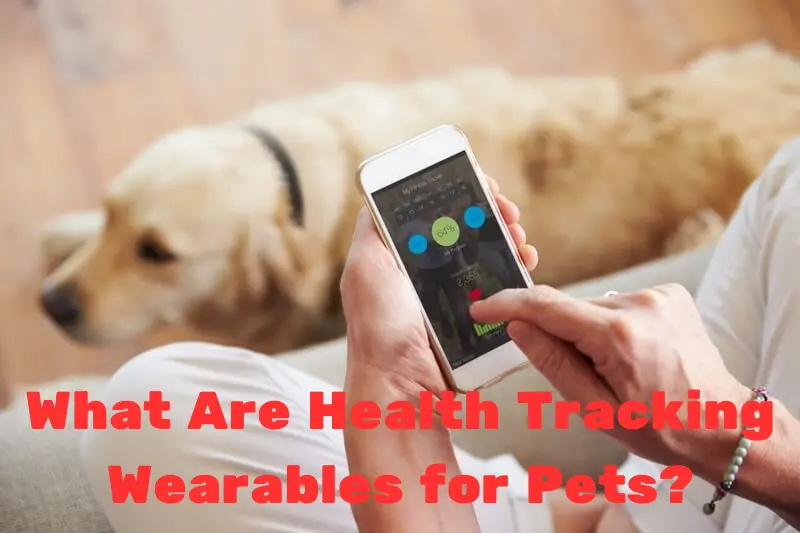As technology becomes increasingly integrated into our daily lives, it’s no surprise that innovations are extending to our pets. Health tracking wearables for pets are an emerging technology designed to help pet owners monitor and improve the health, safety, and well-being of their furry companions. These devices provide valuable insights by collecting and analyzing health and activity data, which can lead to early detection of health issues, better fitness management, and peace of mind.
This article offers a detailed look at pet health tracking wearables: what they are, how they work, their key features, benefits, challenges, popular products, and the future of this technology.
What Are Health Tracking Wearables for Pets?

Health tracking wearables for pets are smart devices designed to be worn by animals—most commonly dogs and cats—to monitor their health and activity. These devices are often built into collars, harnesses, or attachable tags. They collect various types of data such as movement, heart rate, temperature, and location, providing pet owners with real-time insights via smartphone apps or cloud platforms.
By continuously tracking a pet’s physiological data and behaviors, these wearables help owners understand their pet’s health status, detect potential problems early, and ensure their pets stay active and healthy.
How Do Pet Health Wearables Work?
Pet health wearables are equipped with multiple sensors and communication technologies that work together to monitor and transmit data. Here’s a breakdown of how these devices operate:
1. Sensors
- Accelerometer and Gyroscope: These sensors track the pet’s movement, including steps, playtime, rest periods, and even posture or gait. They provide a detailed activity profile.
- Heart Rate Monitor: Measures the pet’s pulse to detect cardiovascular activity and stress levels.
- Temperature Sensor: Records body temperature fluctuations which can indicate illness or overheating.
- GPS Tracker: Provides real-time location data, enabling owners to locate lost pets or monitor their roaming habits.
- Microphone (Optional): Some advanced devices capture sounds like barking or meowing to analyze vocal behavior and stress.
- Pedometer: Counts steps taken to assess fitness levels.
2. Data Transmission
The collected data is usually transmitted through Bluetooth to a paired smartphone app or via cellular connectivity to cloud servers. This allows owners to access detailed reports, set alerts, and share data with veterinarians remotely.
3. Data Analysis
Smartphone apps or cloud platforms analyze the raw data, transforming it into meaningful insights such as activity goals, rest quality, potential health concerns, or abnormal behaviors. Advanced algorithms may use AI to detect subtle changes that might indicate emerging health problems.
You may also like to read this:
Top Dog Wearable Devices For Health And Safety In 2025
Top Smart Pet Health Monitors For Better Pet Care
Best Pet Fitness Tracking Devices For Health & Safety 2025
Pet Health Apps with AI: Transforming Pet Care In 2025
How Tech For Monitoring Pet Vitals Improves Pet Health
Best Dog Heart Rate Monitor For Accurate Health Tracking
Key Features of Pet Health Tracking Wearables
Pet wearables offer various features that help owners monitor and improve their pet’s health and safety:
1. Activity and Exercise Monitoring
Tracking daily activity, including walking, running, playing, and resting, helps ensure pets receive adequate exercise. This is crucial to prevent obesity and maintain cardiovascular health.
2. Heart Rate and Vital Signs Monitoring
Monitoring heart rate and respiratory rate can help detect stress, pain, or early signs of disease. Some devices alert owners if the pet’s vitals fall outside normal ranges.
3. Sleep Quality Analysis
Just like humans, pets need quality sleep. Wearables analyze sleep duration and restlessness, which can signal discomfort or underlying conditions such as arthritis or anxiety.
4. GPS Location Tracking and Geofencing
GPS tracking enables pet owners to locate their pets if they go missing. Geofencing allows setting up safe zones; owners receive alerts if pets leave these designated areas.
5. Behavioral Insights
Changes in activity patterns, vocalization, or restlessness can indicate anxiety, pain, or other behavioral problems. Some wearables can detect these changes and notify owners for timely intervention.
6. Health Alerts and Veterinary Integration
Wearables often come with alert systems that notify owners about abnormal activity or vitals. Many apps allow data sharing with veterinarians, supporting more informed and personalized veterinary care.
Benefits of Using Health Tracking Wearables for Pets
1. Early Detection of Health Problems
Continuous monitoring enables early identification of health issues such as heart disease, infections, or stress before visible symptoms appear. Early detection can improve treatment outcomes and reduce veterinary costs.
2. Improved Fitness and Weight Management
By tracking activity levels, pet owners can ensure their pets get enough exercise to maintain a healthy weight and avoid obesity-related diseases like diabetes or joint problems.
3. Enhanced Safety and Peace of Mind
GPS tracking reduces the risk of lost pets and allows quick recovery. Geofencing alerts help monitor pets’ outdoor activity and keep them safe from dangerous areas.
4. Personalized Health Care
Detailed data helps tailor diet, exercise, and medical treatments to the pet’s specific needs, lifestyle, and health conditions.
5. Better Behavioral Understanding
Wearables provide insights into pets’ emotional and behavioral states, aiding in training and reducing anxiety or stress-related behaviors.
6. Convenient Monitoring
Remote access to pet health data means owners can monitor their pets even when away, ensuring continuous care and quick action in emergencies.
Popular Pet Health Tracking Wearables on the Market

1. FitBark
FitBark is a popular activity and health tracker for dogs that monitors movement, sleep, and calories burned. It integrates with human health apps like Apple Health to allow joint fitness tracking between pets and owners.
2. Whistle Go Explore
Whistle Go Explore offers comprehensive health and GPS tracking with geofencing, real-time location updates, and alerts for unusual activity or boundary crossing.
3. Pawtrack
Specially designed for cats, Pawtrack is a GPS collar that monitors outdoor movement and activity. Its lightweight design makes it comfortable for cats to wear.
4. PetPace
PetPace is focused on health monitoring, tracking vital signs like temperature, heart rate, and respiratory rate. It provides alerts to owners and vets if irregularities are detected.
5. Link AKC Smart Collar
This collar combines GPS tracking, activity monitoring, temperature alerts, and even a built-in LED light for night visibility.
Challenges and Limitations
Despite their benefits, pet health wearables have some challenges:
- Comfort and Fit: Devices must be designed to be comfortable and safe for pets to wear continuously without irritation or discomfort.
- Battery Life: Limited battery life can require frequent charging, which might interrupt continuous monitoring.
- Data Privacy: Ensuring the security and privacy of pet health data is crucial to prevent misuse.
- Cost: High-end wearables can be expensive, potentially limiting access for some pet owners.
- Device Durability: Wearables must be durable and waterproof to withstand pets’ active lifestyles.
- Suitability: Not all wearables are suitable for every pet size or breed; owners must select devices appropriate for their pet’s size and activity level.
The Future of Pet Health Tracking Wearables
As technology evolves, pet wearables will become even more advanced and integrated into daily pet care:
- More Advanced Sensors: Future devices might monitor blood glucose, hydration, or detect specific illnesses like arthritis or infections.
- AI-Driven Diagnostics: Artificial intelligence could analyze data to predict health issues before symptoms develop.
- Integration with Smart Homes: Wearables may connect with home systems to adjust environmental conditions (temperature, humidity) for pet comfort.
- Remote Veterinary Care: Live data could enable remote consultations and real-time monitoring during treatment.
- Customization: Personalized care plans based on genetics, behavior, and environment could be created automatically.
- Broader Species Coverage: Wearables may extend beyond dogs and cats to other pets such as rabbits, birds, or even horses.
How to Choose the Right Health Tracking Wearable for Your Pet
Selecting the right wearable depends on your pet’s needs, lifestyle, and your goals as a pet owner. Here are some important factors to consider:
1. Type of Pet and Size
- Dog or Cat: Some wearables are designed specifically for dogs or cats, considering size, weight, and behavior. For example, a bulky tracker might be uncomfortable for a small cat but fine for a larger dog.
- Breed and Activity Level: Active breeds may require durable and water-resistant devices, while less active or senior pets might benefit more from detailed health monitoring features.
2. Features You Need
- Basic Activity Tracking: If your goal is to encourage exercise and track daily steps, a simple accelerometer-based tracker is sufficient.
- Health Monitoring: For pets with health issues, choose devices that monitor heart rate, temperature, and vital signs.
- GPS Tracking: If your pet tends to wander or escape, GPS functionality with geofencing alerts is crucial.
- Veterinary Integration: Devices that allow data sharing with vets can help with medical supervision and early intervention.
3. Comfort and Durability
Choose a wearable made from pet-safe materials with a comfortable fit. The device should be waterproof or at least water-resistant, especially for pets who love to swim or play outdoors in all weather.
4. Battery Life and Charging
Longer battery life means less frequent charging and continuous monitoring. Some devices offer weeks of battery life, while others require daily charging.
5. App Usability and Support
Check if the companion app is user-friendly, reliable, and offers useful insights. Good customer support from the manufacturer is also essential.
6. Price
Prices vary widely based on features and brand. Set a budget but remember that investing in your pet’s health is valuable for their long-term well-being.
Conclusion
Health tracking wearables for pets offer a powerful way to monitor and improve your pet’s health, safety, and well-being. By providing real-time data on activity, vital signs, and location, these devices help detect health issues early, encourage fitness, and prevent lost pets. Although there are challenges like comfort and battery life, ongoing advancements are making these wearables more effective and accessible.
Choosing the right device depends on your pet’s size, needs, and your care goals. Investing in a quality health tracker can lead to a healthier, happier pet and give you peace of mind as a responsible owner. Ultimately, these smart tools are transforming how we care for our furry friends, ensuring they live safer and fuller lives.
FAQs
1. What types of pets can use health tracking wearables?
Most wearables are designed for dogs and cats, but some models are available or in development for other pets like rabbits, birds, and horses.
2. What health metrics do pet wearables track?
Common metrics include activity levels, heart rate, body temperature, sleep quality, and GPS location. Some advanced devices may also monitor respiratory rate and behavior changes.
3. How do pet health trackers send data?
They typically use Bluetooth to connect to a smartphone app or cellular networks to upload data to cloud platforms for real-time monitoring and analysis.
4. Are these devices comfortable for pets to wear?
Most are designed to be lightweight, durable, and pet-friendly, usually integrated into collars or harnesses. It’s important to choose a size and style suitable for your pet.
5. How often do I need to charge a pet wearable?
Battery life varies by model, ranging from a few days to several weeks. Always check the product specifications and consider your pet’s activity level when choosing.



